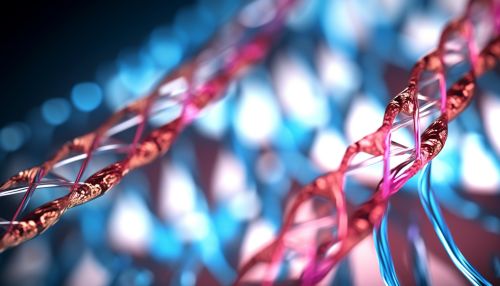Nucleic Acid Structure
Introduction
Nucleic acids are biopolymers, or large biomolecules, essential to all known forms of life. They are composed of nucleotides, which are the monomers made of three components: a 5-carbon sugar, a phosphate group and a nitrogenous base. The two main types of nucleic acids are deoxyribonucleic acid (DNA) and ribonucleic acid (RNA). These molecules carry genetic information and are involved in the synthesis of proteins.
Structure of Nucleic Acids
The structure of nucleic acids is fundamental to their role in living organisms. Both DNA and RNA are polymers of nucleotides. Each nucleotide consists of a sugar, a phosphate group, and a nitrogenous base. In DNA, the sugar is deoxyribose, while in RNA, the sugar is ribose. The sugar and phosphate form the backbone of the nucleic acid structure, while the nitrogenous bases are attached to the sugar.


Nitrogenous Bases
The nitrogenous bases in nucleic acids are divided into two types: purines and pyrimidines. In DNA, the purines are adenine (A) and guanine (G), and the pyrimidines are cytosine (C) and thymine (T). In RNA, thymine is replaced by uracil (U).
Base Pairing
In DNA, the nitrogenous bases pair up across the two strands, forming a double helix. Adenine pairs with thymine, and cytosine pairs with guanine. This is known as complementary base pairing and is due to hydrogen bonding between the bases. In RNA, which is usually single-stranded, base pairing can occur within the molecule itself, leading to the formation of complex structures.
Sugar-Phosphate Backbone
The sugar-phosphate backbone of nucleic acids is formed by phosphodiester bonds between the sugar of one nucleotide and the phosphate of the next. This forms a repeating pattern of sugar-phosphate-sugar-phosphate, which is the backbone of the nucleic acid structure.
DNA Structure
The structure of DNA is a double helix, with two strands of nucleotides twisted around each other. The sugar-phosphate backbones form the outside of the helix, while the nitrogenous bases are on the inside, paired up in the center of the helix.
Double Helix
The double helix structure of DNA was first discovered by James D. Watson and Francis H.C. Crick in 1953. The two strands of the helix run in opposite directions, which is referred to as antiparallel orientation. The bases pair up in the center of the helix, with adenine pairing with thymine, and cytosine pairing with guanine.
DNA Replication
The double helix structure of DNA is crucial for its replication. During replication, the two strands of the helix separate, and each serves as a template for the synthesis of a new complementary strand. This ensures that the genetic information is accurately copied from one generation to the next.
RNA Structure
Unlike DNA, RNA is usually single-stranded, although it can form double-stranded regions through base pairing within the molecule. The structure of RNA is more variable than that of DNA, and it can form a variety of complex three-dimensional shapes.
Types of RNA
There are several types of RNA, each with a different role in the cell. Messenger RNA (mRNA) carries the genetic information from the DNA to the ribosomes, where it is used to synthesize proteins. Transfer RNA (tRNA) and ribosomal RNA (rRNA) are involved in the process of protein synthesis.
RNA Folding
The single-stranded nature of RNA allows it to fold into a variety of complex shapes. This is due to base pairing within the molecule, which can form double-stranded regions. These complex structures are crucial for the function of many types of RNA.
Functions of Nucleic Acids
Nucleic acids have various functions in the cell, all related to the storage and expression of genetic information. DNA stores the genetic information, while RNA is involved in its expression.
DNA as Genetic Material
DNA is the molecule that stores the genetic information in living organisms. This information is encoded in the sequence of the nucleotides, and it determines the characteristics of the organism.
RNA in Protein Synthesis
RNA is involved in the expression of the genetic information. mRNA carries the information from the DNA to the ribosomes, where it is used to synthesize proteins. tRNA and rRNA are also involved in this process.
